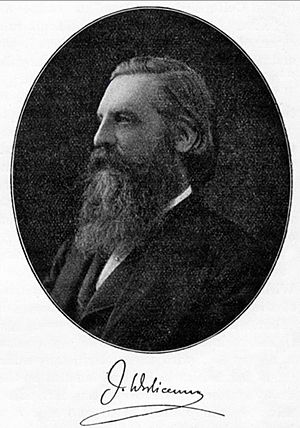Johannes Wislicenus facts for kids
Quick facts for kids
Johannes Wislicenus
|
|
|---|---|

Johannes Wislicenus
|
|
| Born | 24 June 1835 Kleineichstedt, Prussian Saxony
|
| Died | 5 December 1902 (aged 67) |
| Nationality | German |
| Alma mater | University of Halle-Wittenberg |
| Known for | Stereochemistry |
| Awards | Davy Medal (1898) ForMemRS (1897) |
| Scientific career | |
| Fields | Chemistry |
| Institutions | University of Zürich University of Würzburg University of Leipzig |
| Doctoral students | Carl Bosch William Henry Perkin Harold Carpenter |
Johannes Wislicenus (born June 24, 1835 – died December 5, 1902) was an important German chemist. He is best known for his early work in stereochemistry. This is a special part of chemistry that looks at how atoms are arranged in 3D space.
Contents
Life and Education
Johannes Wislicenus was born on June 24, 1835. His birthplace was Kleineichstedt, which is now part of Querfurt, Germany. In 1853, he started studying at the University of Halle-Wittenberg.
Later that year, in October 1853, he moved to the United States with his family. For a short time, he worked as an assistant to a chemist named Eben Horsford at Harvard. In 1855, he became a lecturer in New York.
Wislicenus returned to Europe in 1856. He continued his chemistry studies at the University of Halle.
Career as a Professor
In 1860, Johannes Wislicenus began teaching. He lectured at the University of Zürich and the Swiss Polytechnical Institute. By 1868, he became a full Professor of Chemistry at the University of Zürich.
In 1870, he also became a Professor of General Chemistry. This was at the Swiss Polytechnical Institute in Zürich. He kept both professor roles at the same time.
Later, in 1872, he moved to the University of Würzburg. There, he took over the chemistry department. Finally, in 1885, he became a Professor of Chemistry at the University of Leipzig. He worked there until he passed away on December 6, 1902.
Discoveries in Chemistry
By the late 1860s, Wislicenus focused on organic chemistry. This is the study of carbon-based compounds. He studied different types of lactic acids from 1868 to 1872.
He found two substances that had the same chemical makeup. However, they had different physical properties. He called this "geometrical isomerism." This means the atoms are arranged differently in space.
Wislicenus also supported a theory by J. H. van't Hoff. This theory suggested that carbon atoms are shaped like a tetrahedron (a pyramid with four faces). He believed this shape helped explain how atoms are arranged in a molecule.
While at Würzburg, Wislicenus found a new way to use a chemical called ethyl acetoacetate. This was important for making new organic compounds. He also worked in inorganic chemistry. He found a way to make sodium azide. In 1893, he was the first to create a chemical called cyclopentane.
Awards and Recognition
Johannes Wislicenus received an important award in 1898. He was given the Davy Medal by the Royal Society of London. This medal is a high honor for chemists.
See also
 In Spanish: Johannes Wislicenus para niños
In Spanish: Johannes Wislicenus para niños

